Our Lenses, Your Eyes
Choose how you look at the world by customizing your eyeglasses with the perfect prescription lens.
Sure, finding a great frame is the fun part but don’t think of the lenses as secondary. The lenses are actually more important and once you see the correction they provide and how the world around you is actually more colorful and vibrant, it will excite you.
The correct lens choice will have a significant effect on your overall well being so don’t compromise your eyesight by not being well informed. Let us help you understand your options.
Glossary
Click on an item to expand definition.
Single vision lenses will correct vision for those people experiencing:
- Astigmatism: People who have poor near and distant vision can have astigmatism. Astigmatism is caused by an irregularly shaped cornea that is more oval than round.
Astigmatism is very common and is always accompanied with myopia or hyperopia.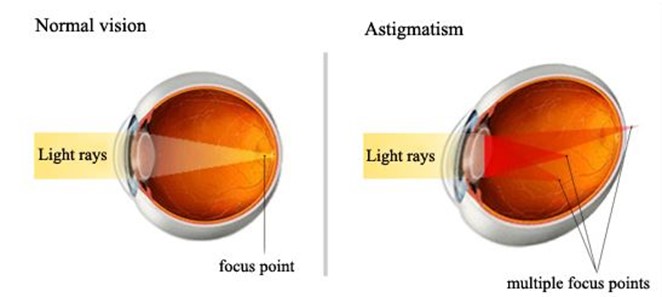
- Myopia: (nearsightedness) People who see well up close but not at a distance.

- Hyperopia: (farsightedness) People who see well at a distance but not close up.

Examples of single vision lens use: eyeglasses for reading(presbyopia), driving, school, movies, TV, and computers.
Some single vision wearers may be able to use their glasses only for a specific activity while others, depending on the prescription, may need to wear their glasses all the time.
Bifocal lenses will correct vision for those people who are experiencing poor distance vision as well as poor close up vision. Bifocal lenses are also worn by people with perfect distance vision and poor close up vision caused by presbyopia.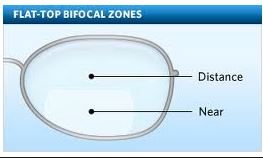
Presbyopia: An age related vision impairment affecting everyone from the age of 45 on regardless of any previous vision history. It is characterized by an inability to see clearly for up close objects, for example, reading. Presbyopia occurs when the crystalline lens loses elasticity, which hampers the ability to focus on near objects.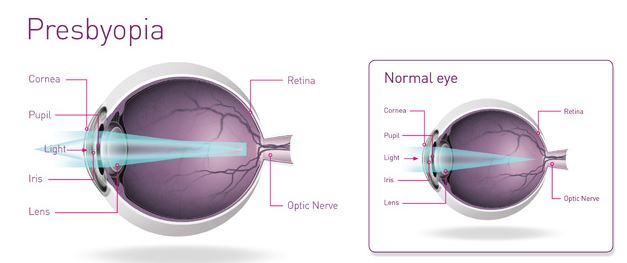
Older Style Bifocals will provide the wearer with distance and near vision but they have a visible separation line, most often seen as a half moon segment which the wearer uses to read. Today the more popular choice is the progressive lens.
Like older style bifocals this type of lens has visible seams. It allows the wearer to see at three distances; far, intermediate, and close up. The draw backs of this lens is that there are two seams to contend with. This lens is still available but used less and less.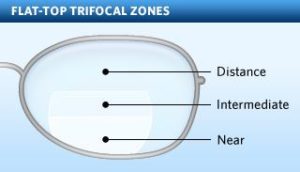
These lenses allow the wearer to see clearly at any distance. The lenses are designed to have a natural seamless transition from distance to intermediate to close vision and back again.
There are many types of Progressive Lenses available. Your professional Optician at Visions Optical can help you determine which will work best for your lifestyle. The new designs are much improved over the first generation of progressive lenses, so don’t let a previous experience scare you away. Try these new lenses for yourself; they are revolutionary!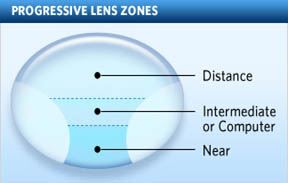
Single Vision/Anti Fatigue Lenses: Designed for people who spend long hours in front of a computer but do not yet require a bifocal. Anti Fatigue lenses offer more comfort for the computer by reducing eye strain.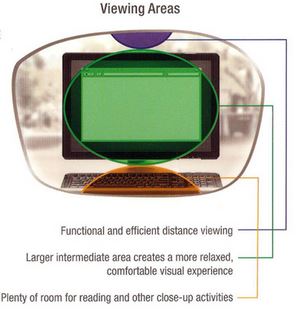
Office Lenses: These lenses are for those who may already wear a progressive Bifocal, but need the convenience of having close up vision and also being able to look up from their desk to see clearly even if they don’t need a distance correction. Office lenses offer an intermediate range of vision (computer and keyboard distance) and a reading range. Users of this type of lens report less eye and neck strain when using the computer.
High index products provide thinner and lighter lenses for those with higher prescriptions. High index lenses can reduce the thickness of a lens considerably, which results in a more pleasing cosmetic appearance and since it is lighter it is more comfortable as well. Choosing high index lenses may increase the number of frame options available to those with higher prescriptions.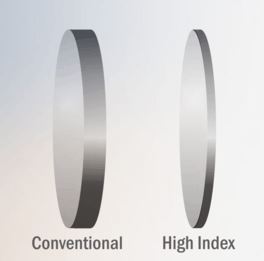
- O.D. stands for “Oculus Dexter” which is Latin for “right eye”
- O.S. stands for “Oculus Sinister” which is Latin for “left eye”
- D.V. “Distance vision” relates to far-sightedness – a condition where distant objects are seen clearly, yet objects close up are seen less clearly.
- N.V. “Near vision” relates to near-sightedness – a condition where near objects are seen clearly, yet objects in the distance are seen less clearly.
- SPH stands for “sphere” and corresponds to numbers that indicate the degree to which a patient is near-sighted or far-sighted
- CYL means “cylinder” and corresponds to numbers that indicate the amount of astigmatism present in a patient’s eyes. Astigmatism is an eye condition resulting from an irregular curvature in the eye causing mild, moderate or severe blurred vision.
- AXIS corresponds to numbers indicating the orientation of astigmatism in the eyes – how and where the irregular curvature occurs.
- PRISM is a prescription element that is added if your eyes need help either working more effectively together or staying in proper alignment.
- PD stands for “Pupillary Distance” and measures the distance between your pupils (in millimeters). This measurement helps ensure your prescription is properly placed in your frames.
- Seg Height is short for “Segment Height” – referring to the near portion or “segment” of the lens and how it aligns in the frame relative to your pupils. It is important when fitting multifocal (bifocal, trifocal or progressive) lenses to achieve optimum use of the reading portion.
